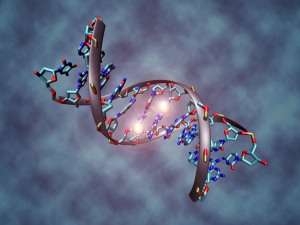Identical twins have largely the same genes. So, how can identical twins not look exactly the same or have the same susceptibility to disease? The phenotypic differences we see in twins prove that our genes are not the only factors in determining physical attributes. One explanation for the differences seen in identical twins is the presence of epigenetic differences.
The article, Epigenetic differences arise during the lifetime of monozygotic twins, features a study which examined the difference in DNA methylation and histone acetylation between 80 identical twins over various ages. Identical twins are the perfect subjects to evaluate the epigenetic causes of phenotypes because the differences between the twin pairs must be a result of factors other than gene sequence.
The epigenome controls the differential expression of genes. DNA methylation and histone modifications, such as acetylation, store epigenetic information that controls heritable states of gene expression. In the article, the study examined different epigenetic characters, which included the abundance of DNA methylation and histone acetylation, as well as the distribution of DNA methylation in chromosomes.
Histones are proteins that, together with DNA, are found in the chromatin in a cell's nucleus. This study examined the acetylation of two specific histones, H4 and H3, as well as methylation of DNA. The technique known as Amplification of Intermethylated Sites (AIMS) was used to determine the specific methylated DNA sequences, which allowed for the determination of the distribution of DNA methylation on chromosomes.
35% of the twin pairs studied had significantly different epigenetic characters between pairs. The twins that were the most epigenetically different were older in age, while the youngest pairs were epigenetically similar. Also, twins with similar amounts of DNA methylation and histone acetylation, and methylation patterns, shared a common distribution of DNA methylation in their chromosomes.
Using the statistical methods, ANOVA and ESD, the epigenetic variability was compared within the twin population and between pairs. Results from these methods determined that the epigenetic variability among individuals is high and similar, regardless of age group. However, older identical twins have higher epigenetic variability between pairs than younger twins. When comparing 3-year old twins with 50-year old twins, the 50-year-old twins were found to have extremely different gene expression. In an older twin pair, there were four times as many differently expressed genes than in the younger twin pair.
Besides age, other factors that were found to possibly contribute to the epigenetic modification pattern differences between twin pairs included the time twins spent with each other and differences in their medical history. Twins who spent the least amount of their lifetimes together or had different medical history were those who also showed the greatest differences in levels of DNA methylation and histone acetylation of histones. Even when comparing different cell types (epithelial mouth cells, intraabdominal fat, and skeletal muscle biopsies), there are striking epigenetic differences in older twins with different lifestyles and that had spent less of their lives together.
The difference in epigenetic patterns that arise during the lifetime of identical twins explains their phenotypic differences. External factors, such as smoking habits, physical activity, or diet, have been proposed to have a long-term influence on epigenetic modifications. Internal factors, such as small defects in transmitting epigenetic information through successive cell divisions, may also play a role in causing different epigenetic modification patterns. Further studies must be done to fully understand the effects of these external and internal factors on the the epigenome. We have much more to learn about the growing research field of epigenetics and how different phenotypes can result from the same genotype.




No comments:
Post a Comment